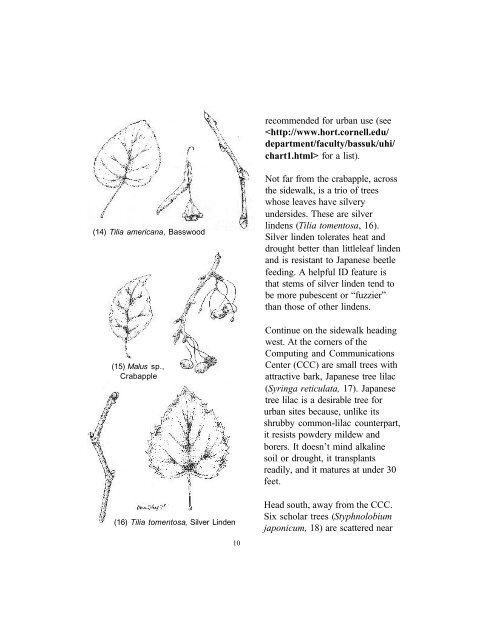Recommended Urban Trees: A Cornell Campus Walk - Horticulture ...
Recommended Urban Trees: A Cornell Campus Walk - Horticulture ...
Recommended Urban Trees: A Cornell Campus Walk - Horticulture ...
You also want an ePaper? Increase the reach of your titles
YUMPU automatically turns print PDFs into web optimized ePapers that Google loves.
(14) Tilia americana, Basswood<br />
(15) Malus sp.,<br />
Crabapple<br />
(16) Tilia tomentosa, Silver Linden<br />
10<br />
recommended for urban use (see<br />
for a list).<br />
Not far from the crabapple, across<br />
the sidewalk, is a trio of trees<br />
whose leaves have silvery<br />
undersides. These are silver<br />
lindens (Tilia tomentosa, 16).<br />
Silver linden tolerates heat and<br />
drought better than littleleaf linden<br />
and is resistant to Japanese beetle<br />
feeding. A helpful ID feature is<br />
that stems of silver linden tend to<br />
be more pubescent or “fuzzier”<br />
than those of other lindens.<br />
Continue on the sidewalk heading<br />
west. At the corners of the<br />
Computing and Communications<br />
Center (CCC) are small trees with<br />
attractive bark, Japanese tree lilac<br />
(Syringa reticulata, 17). Japanese<br />
tree lilac is a desirable tree for<br />
urban sites because, unlike its<br />
shrubby common-lilac counterpart,<br />
it resists powdery mildew and<br />
borers. It doesn’t mind alkaline<br />
soil or drought, it transplants<br />
readily, and it matures at under 30<br />
feet.<br />
Head south, away from the CCC.<br />
Six scholar trees (Styphnolobium<br />
japonicum, 18) are scattered near

















